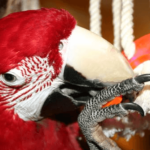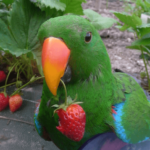
- Mycotoxins are chemical metabolites produced by different varieties of fungi ( fungi ) that proliferate on grain or other foods left standing in a field for a long time ( especially corn for animal consumption, which is often harvested very late in the fall. and which already contains a lot of molds).
- Each fungus has specific light, temperature, and humidity needs that are necessary for its development. If all of these conditions are put together, then the fungus can grow and begin the development of its toxins.

- Always check the freshness and quality of the food you are offering your parrot.
- Store grains and feed in a cool, dry place.
- Never offer your bird peanuts and low-end corn ( animal consumption ), always serve those produced for human consumption.

- Under poor storage conditions, mycotoxins grow rapidly on corn, peanuts, various nuts and grains.
- Mycotoxins are too often found in animal feed containing mainly corn (the first ingredient on the package ) such as commercial feed or other granules.

- Better to buy these foods from reputable companies with a good reputation and always check the expiration date on the packaging.
Mycotoxin poisoning of the parrot

Heavy metal poisoning in parrot
Source: This information is taken from Dr. Corina Lupu M.V. of The Veterinary Hospital for Birds and Exotic Animals 6090 Sherbrooke West.
Lead poisoning is the most common poisoning. The presence and severity of clinical signs depend on the amount ingested, the size of the particles, and the amount of time it has been in the gastrointestinal system.
Once ingested, lead is broken down by stomach acids and absorbed into the bloodstream. In the blood, the lead will cause damage to the gastrointestinal, nervous, renal, and hematopoietic systems.
Clinical symptoms of lead poisoning in parrots are lethargy, depression, anorexia, weakness and loss of balance, regurgitation, polyuria, diarrhea, wasting, head tilt, blindness, dizziness, paralysis, head tremors, convulsions, and death. Some birds may die without clinical signs, and others may only experience weakness and weight loss.
Lead is contained in many products, in and around the house in a discreet way. The precise cause of lead poisoning is often undetermined. Even so-called lead-free paints can contain a toxic level of lead in the drying agent rather than in the base. Exposure may also come from inhalation of toxic vapors (gasoline).
Zinc is another cause of heavy metal poisoning. The galvanized brooch and pliers used in the construction of pens are the most common source. The brighter and more lustrous the pin, the higher the zinc level. galvanized containers are also a source of contamination.
Signs of zinc poisoning in the bird are polyuria, gastrointestinal problems, weight loss, weakness, anemia (bluish coloration due to lack of oxygen), hyperglycemia, and epilepsy. We can also note other signs, such as lethargy, green stools, supine, and death.
Early diagnosis can save the animal. An X-ray and blood tests may show the presence of the metal.
Mercury compounds that are used as condoms in grain storage are also a source of toxicity.
Mycotoxin poisoning of the parrot,Potential sources of lead:
- Lead (used for fishing lines)
- Bells with lead
- Flap Batteries
- Solder Pellets Pellet guns
- Paints
- Varnish
- Lead-free paint (containing a drying agent with lead)
- Hardware fabrics Galvanized
- Pins (lead and zinc)
- Pencil
- Mines Glossy ceramic (mainly imported products)
- Contaminated cuttlefish
- Bones Tinted mirrors (decorative)
- Seeds for planting (coated with lead arsenate)
- Some lubricants (Lead naphthalate)
- Bulb bases
- Linoleum
- Gasoline
- Capours jewellery
- Plaster
Parrot Poisoning by toxic fumes
Parrots are very sensitive to toxic fumes because of their unique and very delicate respiratory system. Vapors considered safe for mammals can be fatal to birds. Prudence should guide our choices. The list of risky products is far from exhaustive but still gives a good indication to help you protect your darlings.
poisoning of parrots with toxic fumes
- Exit quickly parrot outside of the house or away from the source of poisoning and take him where he can breathe fresh air.
- Give the bird air ( artificial respiration if the parrot stops breathing ).
- Quickly find a clinic ( same dog and cat ) and have the parrot give oxygen in an induction chamber ( oxygen cage ), the only really effective way to save the bird.
- Veterinarian: the parrot must be seen by a veterinarian as soon as possible. He will need supportive care, fluids, steroids for pulmonary edema, and antibiotics especially in the case of poisoning with polytetrafluoroethylene ( Teflon ).
Parrot Teflon:
polytetrafluoroethylene (Teflon) poisoning is the most common and leads directly to the death of the bird (pulmonary hemorrhage). Kitchen items coated with a non-stick coating, T-Fal © or Silverstone © style or other of various brands, exposed to heat as low as 285°F or 141°C give off an odorless and colorless vapor, harmless to mammals, but deadly to our parrot. Even more dangerous if the tool is new or very old (scratched). Non-stick kitchen utensils are to be avoided completely in a house where a bird lives (small or large)
- Iron
- Raclette oven
- Waffle iron
- Bread machine
- Minigrill
- Electric fondue dish
- Table stove
- Hair dryers (Teflon coated now)
- Wok
- Etc.
Also, beware of anti-stain treatments that specialists come to your home on your sofas or carpets. Most are Teflon-based and can kill your bird within 12 hours of exposure. Check with the manufacturer before having this work done.
Parrot toxic vapors
Other sources of toxic vapors
- Accumulation of feces
- Hydrochloric acid
- Aerosol (all)
- Ammonia
- Blue barrel (gun cleaner)
- Glues
- Creosote
- DEET (Off, Wilderness, Muskoil)
- Bleach
- Incense / smell-good / shepherd lamp / oil lamp / Plug them in (plug-in) / air freshener deodorant / scented candle / essential oil diffuser / carpet deodorant
- Fertilizers / chemical fertilizers / herbicides
- Hair sprays
- Cigarette smoke / cigar / marijuanna / electronic cigarette / smoke in general
- Propane gas
- Insecticides/pesticides including Vapona platelets ©
- Carbon monoxide (oxide /dioxide)
- Pine oil cleaners (Pine floor)
- Oven cleaners / self-cleaning oven
- Perfumes, aftershave lotions (very volatile)
- Paints / stains / varnishes / strippers / shellac gum / turpentine / wood preservatives (benzene, methanol, toluene, acetone)
- Furniture polished
- Potpourris
- Household cleaning products/detergents
- Shoe and boot protectors
- Carpet and fabric coolers (Febreze genus)
- Developers / fixators / stop baths / photo (darkroom chemicals)
- Hair dyes/perms
- Nail polish/varnish remover
- ETC.
Preventing Toxic Metal Poisoning In Your Parrots
SOURCE:MARLENE MC’COHEN
Related Articles




















